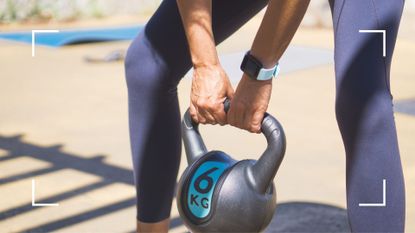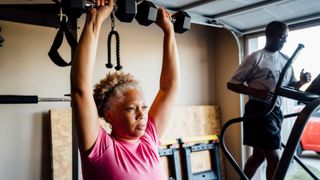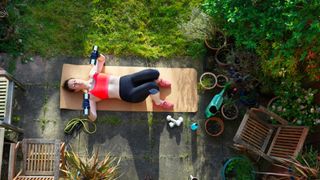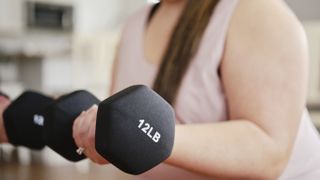Strength training for women - why it’s so important and how to do it at home
Strength training for women could make all the difference to your body and mind, whether it’s using body weight or dumbbells


The benefits of strength training for women have been constantly undervalued over the years in favour of cardio exercises like running and walking. As a fitness routine to get in shape, build strength, or as a way to make time for yourself during the week, this type of training is one of the best activities you can do.
There are many elements to strength training - also called resistance training or sometimes weightlifting - but it essentially comes down to using weight, like a pair of the best dumbbells or resistance bands, to push your muscles to fatigue. Alternatively, you can use your body weight as resistance while you're doing strength training at home for beginners.
It will always be advisable to seek out a certified personal trainer when it comes to strength training as they'll be able to help with the basics and make sure your technique and your form are correct. However, there are some strength training programs you can do at home to get started, with the help of one of the best workout apps.
How is strength training for women different?
Strength training for women is exactly the same as strength training for men. It involves using your own body weight, dumbbells and other weights (such as resistance bands) to build muscle mass, strength, and endurance. You can also attend group classes like Crossfit or take on 1-to-1 personal training at your local gym.
"A good training program should be well-balanced and focused on strengthening all musculature," explains Aroosha Nekonam, senior personal trainer at Ultimate Performance. "You should always be lifting at an effective intensity for growth, progressive overload and effective recovery, regardless of gender."
Adding resistance to your workouts and slowly increasing this resistance over time - by increasing the weight of your dumbells, for example - is called progressive overload. Other forms of resistance include barbells, kettlebells, and weighted plates. Doing this forces your muscles to adapt and encourages them to grow stronger over time, a process that works for both men and women.
Although one difference between men and women when it comes to weight training is that women tend to recover faster than men due to higher estrogen levels, Nekonam notes. "Women can move between their sets quicker while maintaining the same level of intensity," she says. "Women may also find that their performance, metabolic rate and recovery varies throughout their cycle, due to differences in circulating hormones such as estrogen," she says.
Sign up for the woman&home newsletter
Sign up to our free daily email for the latest royal and entertainment news, interesting opinion, expert advice on styling and beauty trends, and no-nonsense guides to the health and wellness questions you want answered.
Despite this, there is a huge training gap between men and women. Research from the University of Northern Iowa suggests that only about 20% of women do any form of strength training regularly, with body image up there as one of the main barriers, compared to 50% of men.
"One worry for women can be not wanting to "bulk up" too much when weight training," personal trainer Jemma Thomas explains. "Weight training can be slightly misunderstood in that sense. It's actually really quite difficult to bulk up, as women have much less testosterone than men. It wouldn't really happen unless you trained for that specific purpose and looked at the nutrition side too."

What are the benefits of strength training for women?
1. Stronger bones
During a strength training workout - whether it's a chair workout or a dumbbell workout for beginners - the muscles pull against the bones in the body, which kickstarts the creation of bone-forming cells. It's very similar to the way that cells are forced to repair muscles that have been overstimulated during a session.
“Strength training helps develop strong bones,” explains personal trainer Aimee Victoria Long, founder of the Body Beautiful Method. “By stressing your bones, strength training can increase bone density and reduce the risk of osteoporosis.”
It's a benefit useful for women of any age but it's especially important for those approaching menopause, explains Nekonam. "One of the symptoms of menopause is a decline in oestrogen, progesterone and androgens, as these are the hormones produced in the ovaries. With declining hormonal levels over time, women will experience muscle and bone mass loss." Strength training can help work against this and prevent bone loss over the years.
2. Reduces the risk of muscle loss in menopause
The loss of oestrogen is also linked to muscle loss, as noted by Nekonam. As well as being one of the more uncomfortable symptoms of perimenopause, personal trainer Emily Servante, who also works with Ultimate Performance, says that "reduced muscle mass puts menopausal women at increased risk of falls and bone fractures, as well as the health risks associated with poorer body composition, such as high blood pressure, type 2 diabetes, and so on."
She says, "Resistance training helps provide the stimulus to the body to retain, maintain and build muscle mass to keep you agile throughout life."
But maintaining good muscle mass isn't only essential for daily movement. "A healthy level of muscle is absolutely imperative to the maintenance of a speedy and efficient metabolism and, in my experience, this is a crucial factor ignored by far too many women," says Servante. “This is a factor that becomes increasingly significant for women as they age, as hundreds of studies have demonstrated that age-related muscle loss is the significant factor in the slowing down of the metabolic rate as we grow older. To put that into real terms, by the age of 65, this equates to a daily drop in metabolic rate of 500 calories, which puts a severe dent in the ability to stay in shape."
Supplementing your diet and strength training routine with supplements such as a good creatine for women and one of the best protein powders can also help with this.
“However, it is not all doom and gloom. Studies of over 60s who do the right things via their exercise and diets have shown that they have only a 0.36% metabolic drop per decade versus the norm of 5-7%."

3. Relieves back pain
Strength training relieves back pain by strengthening the key muscles in your body, along with increasing the range of motion your spine is capable of. "With correct form and posture, you'll be switching on your core muscles and all around your abdominals, which will strengthen that area," Thomas says. "In turn, this creates much better support for your back. Your posture will start to improve and with that backache can also significantly reduce."
While you may think that bending down to pick up relatively heavy weights is a no-go, a program of heavy-load lifting has been proven to reduce lower back pain by re-training the body's movement patterns. A study by the Luleå University of Technology looked at patients with the issue over 2 years and found those who take up strength training were up to 80% more likely to report a decrease in pain intensity and disability in both the short and long term. This is partially because focused strength training encourages you to think about how your muscles move, encouraging you to engage them in an active way when it comes to particular movements. When translated to the real world, you're more likely to follow similar movement patterns when picking up heavy loads in daily life, reducing your chance of injury.
However, if you do suffer from back pain, it's important to refer to a medical professional to check it's not more serious and you're cleared to lift weights, as you don't want to cause more damage, Nekonam advises. "It will also be best to enlist the help of a personal trainer who can support and guide you with proper technique, and form and help you progressively build strength without injuring yourself," she adds.
4. Strength training can help you burn fat
Yes, including one of the many types of squats in your workout can help you lose fat mass. "One of the key benefits of resistance exercise is the maintenance and improvement of a healthy body fat, through building muscle and losing fat," Nekonam says. "Resistance exercise can also counter unwanted weight gain and help combat the increased risk of cardiovascular disease and diabetes."
While it may not rack up as many calories burnt on your fitness tracker compared to cardio-based at-home workouts or LISS cardio like running, increasing your muscle mass helps to increase your metabolism and this, in turn, helps you burn more calories in the hours after your strength training workout. This is known as the after-burn effect, or more specifically, excess post-exercise oxygen consumption (EPOC).
But when it comes to strength training and losing fat, there's something else to bear in mind. Typically when you start exercising, especially if it's for the first time in a while, your hunger hormones will shoot up, leading to the urge to consume more food. This is where eating enough protein and the benefits of protein powder come into their own. Studies from the Harvard School of Public Health show that this macronutrient helps us to feel full and supports the health of growing muscles. To get the most out of your training, aim to consume one gram of protein for each kilogram of your ideal body weight.
If weight loss is something you're interested in, some of the best low-calorie, high-protein foods will be useful too.

5. Strength training can help you build confidence
There are more than just physical benefits to strength training for women as well. It's commonly understood that exercise - regardless of whether that's running every day, going cycling as a workout, or resistance training - improves our mood for up to 24 hours after exercise, and suppresses the sympathetic nervous system (i.e. 'the flight or flight response' to stress), per research on the subject summarised in a review by New York University.
The review also explains how we can experience significant improvements in cognitive function - such as decision-making, problem-solving, and working memory - after just one singular session of exercise, regardless of intensity, and the effects can last for up to two hours after the session has finished.
When should you strength train and how often?
Anywhere between once a week and four times a week is ideal if you're just starting out, our experts say, but it depends on how much exercise you do already. If your cardio fitness is good, thanks to running or cycling, you're more likely to adapt to strength training faster. Equally, if you already do some light resistance training by wearing a weighted vest for walking, for example, then you'll be in better starting position.
If you're a beginner and just learning how to start weightlifting, you may need to go a little slower. "To start, and to get your body used to strength training, I would suggest twice a week for a few weeks then you can introduce a third session if possible," PT Thomas says.
Nekonam agrees. "How many times a week you train will depend on your goal, but on average training three to four days a week is a good amount to ensure effective recovery time," she says.
As you advance throughout your strength training sessions, whether that's in person or via the best strength training apps, continue doing the same compound lifts but add additional weight. You can also mix up your exercises and repetitions. Do what feels comfortable at this point but continue to challenge yourself a little, and make those muscles work.
As for the best time to exercise, it depends on how you feel. Some people find it best to work out first thing on an empty stomach while others need some fuel beforehand. If you fall into the second category, carbohydrates are going to be the best bet - either a portion of slow-release carbohydrates for dinner, such as whole grain rice or wholemeal pasta, or a portion an hour or two before you train. This could be something like a bowl of oats in the morning before a midday workout or in the afternoon before an evening workout.
How to strength train at home without equipment
- Split squats
- Single leg deadlifts
- Single leg glute bridges
- Push-ups
- Pull-ups
- Planks
Split squats
- Stand tall, feet hip-width apart. Place hands on hips and step forward with your right leg, into a staggered stance.
- Slowly lower your body down, keeping your torso upright and gaze forward.
- When your back knee is hovering just above the ground, push up through your front foot back to your staggered stance.
- Repeat eight to 10 times
- Swap legs and repeat another round.
- Once you feel confident working out with your body weight, add in some dumbells.
Single leg deadlifts
- Using a dumbbell or a heavy water bottle to add resistance to this move, stand with feet hip-width apart.
- Lean forward, shifting all your weight onto one leg. Your other leg needs to engage and slowly come off the ground and extend straight behind you.
- Keep going until your body is essentially in a T position with your back extended leg straight out behind you and your torso almost parallel to the ground.
- Push through the foot on the ground to slowly bring in your extended leg and return to the start position. Repeat 10 times before swapping and repeating 10 times with the other leg.
Single leg glute bridges
- Lie flat on your back on a mat or the ground.
- Bend your right knee and place your right foot on the mat. Your left leg should extend out in front of you.
- Keeping a stable spine, push through your right foot, bring your hips up and keep your left leg straight out.
- Hold this position, squeezing the glutes (your butt muscles), then slowly lower back down. Repeat 10 times on each side.
Push-ups
- You might want to start on your knees for this one.
- Keep your back straight and place your hands below your shoulders, just slightly wider than your shoulders.
- Lower your body down towards the ground, bending the elbows as you do so, then slowly push yourself back up to the start. Repeat 10 times.
Pull-ups
- Typically you need a bar for pull-ups. However, a door frame can be just as effective at home. Or, you can invest in some long resistance bands to loop over your door.
- However you decide to do it, keep your body straight, pull yourself up as far as you can off the floor, and bend your elbows as you do so, keeping them close to your sides.
- There are several transitional points you can start with if you're not ready for a full pull up though, including lat pull-downs.
Planks
- This is a simple move that can be done anywhere. Although you might want to invest in one of the best thick yoga mats to keep your joints protected when planking.
- Lie on the floor, then lift yourself onto your forearms keeping your elbows under your shoulders. Place hands flat on the floor. Your body should be resting on your forearms and your toes.
- Keep your body engaged, head down and hold this position. You may want to do it near a mirror so you can check that your body is in a straight line. Aim to hold for 20 seconds, increasing the time as you become stronger.

Grace Walsh is woman&home's Health Channel Editor, working across the areas of fitness, nutrition, sleep, mental health, relationships, and sex. She is also a qualified fitness instructor. In 2024, she will be taking on her second marathon in Rome, cycling from Manchester to London (350km) for charity, and qualifying as a certified personal trainer and nutrition coach.
A digital journalist with over six years experience as a writer and editor for UK publications, Grace has covered (almost) everything in the world of health and wellbeing with bylines in Cosmopolitan, Red, The i Paper, GoodtoKnow, and more.
-
 Concealer as primer and doubled-up blush: Our beauty team's one-minute tricks for expensive-looking makeup that lasts
Concealer as primer and doubled-up blush: Our beauty team's one-minute tricks for expensive-looking makeup that lastsUsing products already in your collection, these easy tips will unlock an effortlessly chic look in no time...
By Sennen Prickett Published
-
 Can you touch your toes? Try these 6 easy mobility exercises if you can't
Can you touch your toes? Try these 6 easy mobility exercises if you can'tEasy mobility exercises are a simple way to test your flexibility and stability. Here, a chiropractor reveals his go-to moves
By Grace Walsh Published



